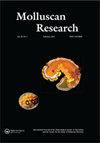Characterisation of an individual of the giant form of the purpleback flying squid Sthenoteuthis oualaniensis (Cephalopoda: Ommastriphidae) in the Arabian Sea and its biological descriptors
IF 0.6
4区 生物学
Q3 ZOOLOGY
引用次数: 2
Abstract
ABSTRACT This paper describes a mated female of the giant form of purpleback flying squid Sthenoteuthis oualaniensis (545 mm dorsal mantle length and 5.46 kg body weight) caught in the Arabian Sea, with biological, morphological, and molecular descriptors. Based on the growth increments within statoliths, its age was found to be 203 days with a high growth rate of 2.68 mm DML/day. Its diet contained squids (72.3%) and fish (27.3%) with a high degree (70%) of cannibalism. The total fecundity of the individual was estimated as 702,240 eggs. Three species of parasites were found, two species of Platyhelminthes from the mantle cavity (Phyllobothrium sp. and Nybelinia sp.) and one of Nematoda from the stomach (Anisakis simplex). The COI barcode confirmed the identity of the giant form as S. oualaniensis, and the high genetic divergence (6.18–9.35%) that was observed between the current specimen and other forms from various oceans points to the probability that it might be a genetically distinct lineage from the northern Indian Ocean. The present record forms the southernmost (10°05′ N) record of the giant form of this flying squid.阿拉伯海中一只巨大的紫背飞乌贼Sthenoteuthis oualaniensis(头足目:头足目)个体的特征及其生物学描述
摘要本文用生物学、形态学和分子描述符描述了一只在阿拉伯海捕获的巨大紫背飞乌贼(背鞘长545毫米,体重5.46公斤)的交配雌性。根据定子石内的生长增量,发现其年龄为203天,高生长率为2.68 mm DML/天。它的饮食中含有鱿鱼(72.3%)和鱼类(27.3%),其中自相残杀的程度很高(70%)。个体的总繁殖力估计为702240个卵。发现三种寄生虫,两种来自套腔的扁线虫(Phyllobothrium sp.和Nybelinia sp.)和一种来自胃的线虫(Anisakis simplex)。COI条形码证实了这一巨型标本的身份,即S.oualaniensis,在目前的标本和来自不同海洋的其他标本之间观察到的高度遗传差异(6.18–9.35%)表明,它可能是北印度洋的一个遗传上不同的谱系。目前的记录形成了这种巨型飞行乌贼最南端(北纬10°05′)的记录。
本文章由计算机程序翻译,如有差异,请以英文原文为准。
求助全文
约1分钟内获得全文
求助全文
来源期刊

Molluscan Research
生物-动物学
CiteScore
1.80
自引率
10.00%
发文量
27
审稿时长
>12 weeks
期刊介绍:
Molluscan Research is an international journal for the publication of authoritative papers and review articles on all aspects of molluscan research, including biology, systematics, morphology, physiology, ecology, conservation, biogeography, genetics, molecular biology and palaeontology.
While the scope of the journal is worldwide, there is emphasis on studies relating to Australasia and the Indo-west Pacific, including East and South East Asia. The journal’s scope includes revisionary papers, monographs, reviews, theoretical papers and briefer communications. Monographic studies of up to 73 printed pages may also be considered.
The journal has been published since 1957 (as the Journal of the Malacological Society of Australia until 1993). It is free to members of the Malacological Society of Australasia and the Society for the Study of Molluscan Diversity.
 求助内容:
求助内容: 应助结果提醒方式:
应助结果提醒方式:


